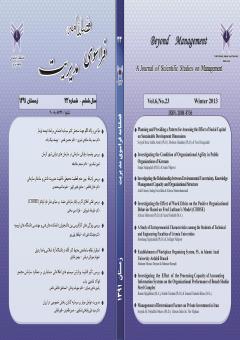استقرار نظام ساماندهی محیط کار، 5S، در دانشگاه آزاد اسلامی واحد اردبیل
محورهای موضوعی : مدیریت بازرگانیشهرام میرزایی دریانی 1 , بهمن شارقی 2
1 - عضوهیأت علمی گروه مدیریت، واحد اردبیل، دانشگاه آزاد اسلامی،اردبیل، ایران-( بورسیه دکترای تخصصی مدیریت صنعتی گرایش سیستم)
2 - کارشناس طرح و برنامه دانشگاه آزاد اسلامی واحد اردبیل
کلید واژه: بهبود مستمر, مدیریت کیفیت, مدیریت منابع, ساماندهی محیط کار, مدیریت اتلاف, مدیریت بهرهوری,
چکیده مقاله :
سازمانها در هر مرحله ای از عمر خود و همچنین متأثر از فضای رقابتی پیرامون موجود، میدانند که بایستی از منابع، استفاده بهینهای به عمل آورند. ساماندهی محیط کار، 5S، از جمله رویکردهایی است که بهرهوری و تعالی سازمانی را امکانپذیر میسازد. مزایا و منافع حاصل از به کارگیری این نظام در ابعاد اقتصادی، فرهنگی و اجتماعی سیستمهای انسانی در سطوح خرد و کلان، نشانگر جایگاه مهم این طرح نوین مدیریتی میباشد. موضوع طرح پژوهشی حاضر، بررسی استقرار 5S همراه با اقدامات لازم در خصوص بسترسازی آن بوده است. مسئولین و کارکنان با درک نکات مفهومی 5S در کاهش هر نوع اتلافها و در نتیجه بهبود روشها و بهینهسازی سیستمها، با علاقهمندی روزافزونی برای استقرار طرح مذکور مشارکت نمودهاند. تحلیل یافتههای حاصل از آزمون آماری t یک نمونهای بر روی پرسشنامه پژوهشگرساخته نشان میدهد که مسئولین و کارکنان به کارگیری ابعاد پنجگانه 5S را مورد تأیید قرار دادهاند. استفاده مطلوب از منابع، حذف به موقع مواد غیرضروری، ریشهیابی موفقیتآمیز آلودگیها، بازنگری در استانداردهای موجود، افزایش تعهد مسئولین و کارکنان، بهبود سیستمهای ارتباطی افراد، اهمیت به شناسایی هر نوع اتلاف با هدف کاهش انواع آن موارد قابل مشاهدهای میباشند که در دانشگاه آزاد اسلامی واحد اردبیل بر اساس استقرار این طرح به وقوع پیوستهاند.
Organizations at every stage of their life and affected by the competitive atmosphere of the existing environment know that they must make optimum use of resources. Workplace organizing system, 5s, is one of the approaches that make organizational productivity and excellence possible. The advantages and benefits of applying this system in the economic, cultural and social dimensions of the human system at micro ad macro levels indicate the important status of this new managerial design. The purpose of the present research is to investigate the establishment of 5s along with the necessary measures to pave the way for it. Managers and employees by understanding the conceptual points of 5s in reducing all kinds of wastage, improving the procedures, and optimizing the systems, have contributed with increasing interest to the establishment of the system. Analysis of the findings obtained from one-sample t-test of the researcher-made questionnaire indicated that both managers and employees have confirmed the establishment of 5s. Optimal use of resources, timely elimination of unnecessary materials, successful spotting of the root causes of pollutions, revision of the existing standards, increasing managers and employees’ commitment, improving people’s communication systems, placing importance to the identification of any kind of wastage with the aim of reducing its types have been the instances observed at Islamic Azad University, Ardabil Branch based on the establishment of 5s system.
Abutalebi, R. (2005). 5S The Basis of Implementation of TQM and the Achievement of Business Excellence. Baztab Publication, (In Persian).
Arabian, R. (2009). 5S This Machine of Change and Change. The Publication of the Center for Industrial Research and Training, (In Persian).
Hiryuki, H. (2002). Work Organization. Translated by: M. Al Khorshid, Mighate Noor Publication, (In Persian).
Imaj. M, (1996), "Kaizen: The Key to Japan's Competitive Success", New York, McGraw Hill
Khan Mokhtari, B. (2004). The Five Principles of Adornment in the Workplace, Sufis, (In Persian).
Machinnes. Richard L, (2005), "The Lean Enterprise Memory Jogger", Decission Sciences, 21(2), 416-437
March. Winsky, chatt. Shoch. Can, (2004), ''lean lexion: A Graphical for Lean Thinkness'' Lean Enterprise Institute
Nagashima. Soichiro, (2004),''Keiei 100-hyo=100 Management Charts''
Taheri, Sh. (2004). Productivity and Analysis in Organizations. Tehran: Hastan Publications, (In Persian).
Toshia, K., & Fardi, S. (1993). Five Practices for Organizing Work Environment. National Productivity Organization, (In Persian).
Tsu chiya. Kazeo, (2002), ''Super 5s in for Every One: A Nation Grows With Improved Productivity''
Turner. Suzanne, (2004), ''Tools for Succes: A Managers Guide,''
Osada, T. (1972). Five Principles for Achieving Excellence in the Workplace. Translated by: A. R. Zinatbakhsh, National Productivity Organization of Iran, (In Persian).
Peterson. James, Smith. Roland, (1998), "The 5S Pocket Guide", Productivity Press.
Fabrizio. Thomas A, Tapping. Don, (2006), "5S for the office: Organizing the workplace to Eliminate waste", Productivity Press.
_||_Abutalebi, R. (2005). 5S The Basis of Implementation of TQM and the Achievement of Business Excellence. Baztab Publication, (In Persian).
Arabian, R. (2009). 5S This Machine of Change and Change. The Publication of the Center for Industrial Research and Training, (In Persian).
Hiryuki, H. (2002). Work Organization. Translated by: M. Al Khorshid, Mighate Noor Publication, (In Persian).
Imaj. M, (1996), "Kaizen: The Key to Japan's Competitive Success", New York, McGraw Hill
Khan Mokhtari, B. (2004). The Five Principles of Adornment in the Workplace, Sufis, (In Persian).
Machinnes. Richard L, (2005), "The Lean Enterprise Memory Jogger", Decission Sciences, 21(2), 416-437
March. Winsky, chatt. Shoch. Can, (2004), ''lean lexion: A Graphical for Lean Thinkness'' Lean Enterprise Institute
Nagashima. Soichiro, (2004),''Keiei 100-hyo=100 Management Charts''
Taheri, Sh. (2004). Productivity and Analysis in Organizations. Tehran: Hastan Publications, (In Persian).
Toshia, K., & Fardi, S. (1993). Five Practices for Organizing Work Environment. National Productivity Organization, (In Persian).
Tsu chiya. Kazeo, (2002), ''Super 5s in for Every One: A Nation Grows With Improved Productivity''
Turner. Suzanne, (2004), ''Tools for Succes: A Managers Guide,''
Osada, T. (1972). Five Principles for Achieving Excellence in the Workplace. Translated by: A. R. Zinatbakhsh, National Productivity Organization of Iran, (In Persian).
Peterson. James, Smith. Roland, (1998), "The 5S Pocket Guide", Productivity Press.
Fabrizio. Thomas A, Tapping. Don, (2006), "5S for the office: Organizing the workplace to Eliminate waste", Productivity Press.

